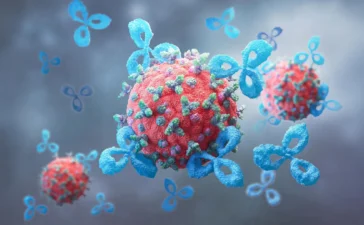How can the latest technology, such as solar cells, be improved? An international research team led by the University of Göttingen is helping to find answers to questions like this with a new technique. For the first time, the formation of tiny, difficult-to-detect particles — known as dark excitons — can be tracked precisely in time and space. These invisible carriers of energy will play a key role in future solar cells, LEDs and detectors. The results were published in Nature Photonics.
Dark excitons are tiny pairs made up of one electron together with the hole it leaves behind when it is excited. They carry energy but cannot emit light (hence the name “dark”). One way to visualise an exciton is to imagine a balloon (representing the electron) that flies away and leaves behind an empty space (the hole) to which it remains connected by a force known as a Coulomb interaction. Researchers talk about “particle states” that are difficult to detect but are particularly important in atomically thin, two-dimensional structures in special semiconductor compounds.
In an earlier publication, the research group led by Professor Stefan Mathias from the Faculty of Physics at the University of Göttingen was able to show how these dark excitons are created in an unimaginably short time and describe their dynamics with the help of quantum mechanical theory. In the current study, the team has now developed a new technique known as “Ultrafast Dark-field Momentum Microscopy,” and used it for the first time. This enabled them to show how dark excitons are formed in a special material made of tungsten diselenide (WSe₂) and molybdenum disulphide (MoS₂) — and in an astonishing time, lasting just 55 femtoseconds (0.000000000000055 seconds) measured with a precise resolution of 480 nanometres (0.00000048 metres).
“This method enabled us to measure the dynamics of charge carriers very precisely,” explains first author Dr David Schmitt, also from Göttingen University’s Faculty of Physics. “The results provide a fundamental insight into how the properties of the sample influence the movement of the charge carriers. This means that this technique can be used in future to specifically improve the quality and therefore also the efficiency of solar cells, for example.” Dr Marcel Reutzel, Junior Research Group Leader in Mathias’ research group, adds: “This means that this technique can be used not only for these specially designed systems, but also for research into new types of materials.”
The research was supported by the DFG-funded Collaborative Research Centres “Control of Energy Conversion on Atomic Scales” and “Mathematics of Experimentation” in Göttingen and the Collaborative Research Centre “Structure and Dynamics of Inner Interfaces” in Marburg.
You Might Also Like
Eating more vitamin C can physically change your skin
Scientists at the University of Otago, Faculty of Medicine -- Christchurch Ōtautahi, have identified a direct connection between how much...
MIT scientists strip cancer of its sugar shield
A research team from MIT and Stanford University has developed a new technique designed to push the immune system to...
This “mushroom” is not a fungus, it’s a bizarre plant that breaks all the rules
In the damp shade beneath moss-covered trees, high in the mountains of Taiwan and mainland Japan or deep within the...
A quantum mystery that stumped scientists for decades is solved
A global research team led by Rice University physicist Pengcheng Dai has verified the presence of emergent photons and fractionalized...









